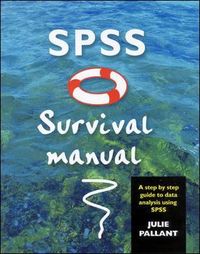
SPSS Survival Manual
"An excellent introduction to using SPSS for data analysis...extremely useful for undergraduate students, and covers a good range of material often not found in competing texts. It provides a self-contained resource itself, with more than simply (detailed and clear) step-by-step descriptions of statistical procedures in SPSS. There is also a wealth of tips and advice, and for each statistical technique a brief, but consistently reliable, explanation is provided." - George Dunbar, University of Warwick
"This book is an excellent addition to the research methods literature. It presents the research process, research strategy and SPSS techniques in manageable steps offering clear advice, useful tips and discussion of relevant issues such as assumptions and effect size...this text is written in an encouraging and supportive style. I believe students will read and learn with this book." - David Cairns, Macquarie University, Australia
The SPSS Survival Manual throws a lifeline to students and researchers grappling with SPSS. Written in a friendly, jargon-free style, it demystifies statistics and data analysis by guiding you through the entire research process and helping you to choose the right statistical technique for your project. From the formulation of research questions, to the design of the study and analysis of data, to reporting the results, Julie Pallant discusses basic and advanced statistical techniques. She outlines each technique clearly, with step-by-step procedures for performing the analysis, a detailed guide to interpreting SPSS output and an example of how to present the results in a report. The user-friendliness of the manual is enhanced by spiral binding which makes it easy to use at a computer. A recommended reading section points the reader towards additional sources of advice. Illustrated with screen grabs, examples of output and tips, and supported by a website (www.openup.co.uk/spss) with sample data and guidelines on report writing, the SPSS Survival Manual can be used by students and researchers at any level alongside any major statistics textbook.
Utgiven: 2001
ISBN: 9780335208906
Förlag: Open University Press
Format: Bok
Språk: Engelska
Sidor: 304 st
"An excellent introduction to using SPSS for data analysis...extremely useful for undergraduate students, and covers a good range of material often not found in competing texts. It provides a self-contained resource itself, with more than simply (detailed and clear) step-by-step descriptions of statistical procedures in SPSS. There is also a wealth of tips and advice, and for each statistical technique a brief, but consistently reliable, explanation is provided." - George Dunbar, University of Warwick
"This book is an excellent addition to the research methods literature. It presents the research process, research strategy and SPSS techniques in manageable steps offering clear advice, useful tips and discussion of relevant issues such as assumptions and effect size...this text is written in an encouraging and supportive style. I believe students will read and learn with this book." - David Cairns, Macquarie University, Australia
The SPSS Survival Manual throws a lifeline to students and researchers grappling with SPSS. Written in a friendly, jargon-free style, it demystifies statistics and data analysis by guiding you through the entire research process and helping you to choose the right statistical technique for your project. From the formulation of research questions, to the design of the study and analysis of data, to reporting the results, Julie Pallant discusses basic and advanced statistical techniques. She outlines each technique clearly, with step-by-step procedures for performing the analysis, a detailed guide to interpreting SPSS output and an example of how to present the results in a report. The user-friendliness of the manual is enhanced by spiral binding which makes it easy to use at a computer. A recommended reading section points the reader towards additional sources of advice. Illustrated with screen grabs, examples of output and tips, and supported by a website (www.openup.co.uk/spss) with sample data and guidelines on report writing, the SPSS Survival Manual can be used by students and researchers at any level alongside any major statistics textbook.
Begagnad bok (0 st)
Varje vecka tillkommer tusentals nya säljare. Bevaka boken så får du meddelande när den finns tillgänglig igen.



